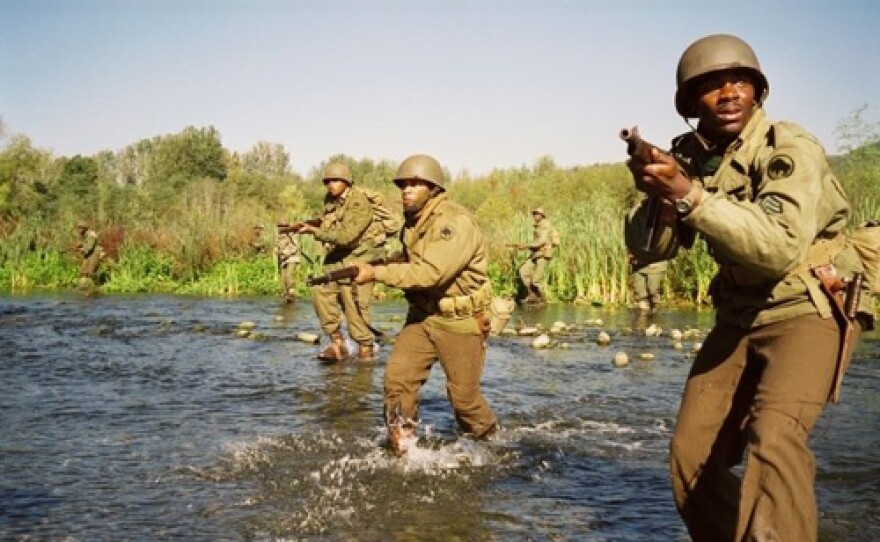The film opens in the not too distant past of Harlem, 1983. Hector Negron (Laz Alonso) is watching a John Wayne World War II movie on TV. As Negron watches we sense he's wondering where all the Hollywood films are about the role African Americans played in the war. "We fought for this country too," he says. But then at work the next day this aging postal worker just a few months shy of retirement pulls out a World War II German Lugar and shoots a male customer to death. Negron has a squeaky clean past as well as a Purple Heart and since he refuses to say anything, the cops are clueless as to his motivation for the crime. Adding a layer of complication is the fact that the cops find a 450-year-old artifact worth millions of dollars in Negron's closet. A neophyte reporter (Joseph Gordon-Levitt in a completely superfluous role) tries to pry the story out of Negron and this prompts a flashback.
An African American soldier befriends an Italian boy in Miracle at St. Anna. (Touchstone)
After a violent battle in which the white officers fail to believe the information provided by the black soldiers and consequently fail to provide them with proper support, four of the men from the 92nd head toward the tiny mountainous village of Colognora. The men are Second Staff Sergeant Aubrey Banks (Derek Luke); Sergeant Bishop Cummings (Michael Ealy); Cpl. Hector Negron (Laz Alonso), and PFC Sam Train (Omar Benson Miller). Along the way, Train picks up an injured seven-year-old Italian boy, Angelo (Matteo Sciabordi), who seems to be talking to an imaginary friend. The hulking American and the fragile Italian boy form a powerful bond that is the heart and soul of the film.
Lee makes the film consistently compelling but he fails to invest it with the intensity and cohesiveness of his more personal projects. The film also lacks the genre savvy he displayed just recently with the thriller Inside Man. In Miracle, Lee neither explodes the war film conventions nor does he hone them to perfection. He seems stranded between the social issues that have always interested him (racial prejudice, social inequality) and a sentimental tale of faith and miracles. It's almost as if Lee was making a war film about the Buffalo soldiers while screenwriter James McBride (adapting from his own book) was making a very different film about angels, miracles, superstition and the supernatural. Miracle lacks focus as Lee keeps heading off on tangents, sometimes providing a flashback within a flashback or a throw away scene (like an early one with John Leguizamo) that could have easily been excised to streamline the story. McBride's script doesn't develop much depth even though it clocks in at 160-minutes. Plus the script often spells out the points it's trying to make rather than forcefully illustrating them. So Banks ends up telling us, "I love Italy. I ain't a n-----r here." Similarly, a black aide to a white officer feels compelled to explain how racism functions in the military, and Lee serves up a rather obvious montage of blacks, Germans and Italians praying in their separate churches but essentially to the same God and with the same hopes for an end to the fighting. The sentimental tacked on ending doesn't help either and we leave the theater feeling that not all our questions have been answered.

Derek Luke as a soldier in Miracle at St. Anna (Touchstone)
But Lee does well conveying the horror and chaos of battle, and the cold-blooded chill of seeing innocent people slaughtered. He also gives us a fascinating glimpse of Germany answer to Tokyo Rose with Axis Sally who plays on racism in an attempt to lower the morale of the black soldiers. There are also some nice moments between Train and Angelo, neither of who has ever been this close to someone of a different race.
Little Matteo Sciabordi stands out in the cast as being the one most able to find the magic needed to make us buy into the miracle. But we're not entirely sold. Omar Benson Miller (who has a supporting role in the upcoming The Express ) gives us a gentle giant with more heart than brains, but he surprises us with courage when Angelo needs protecting.
Miracle at St. Anna (rated R for strong war violence, language and some sexual content/nudity) is not Lee at his best but there's enough of merit to make it a worthwhile experience, especially if you are a fan of Lee's.
Companion viewing: Clockers, Inside Man, Pan's Labyrinth






